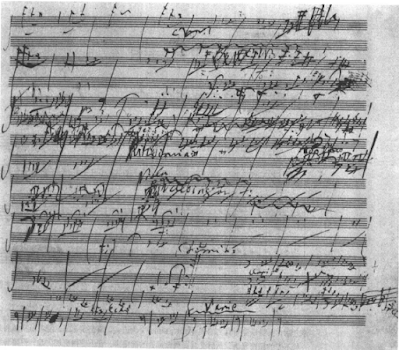CXIII. BERG, Alban (1885-1935)
Lyric Suite (1925-26)
1. Allegretto gioviale
2. Andante amoroso
3. Allegro misterioso -- Trio estatico
4. Adagio appassionato
5. Presto delirando -- Tenebroso
6. Largo desolato
Secession Quartet
Stephanie Ko, violin
Makiko Iwakura, violin
Chia-Chin Hsiao, viola
Kenta Uno, cello
(32:19)
This great masterpiece is filled with hidden secrets.
As we discussed in the Violin Concerto (Post VI), Berg didn't use a twelve-tone row in the same manner as his fellow Viennese School composers, Schoenberg and Webern.
He might use a kosher row with 12 notes, none repeated -- but he would form the notes of the row into interval groups.
Let's look at the first three bars:

Specifically, the first violin part:
Notes 1-2 form a Minor Second
Notes 3-4 form a Minor Third
Notes 5-6 form a Perfect Fourth
Notes 7-8 form a Perfect Fifth
Notes 9-10 form a Major Sixth
Notes 11-12 form a Major Seventh
(note the C-Flat is written enharmonically as a B-Natural)
We can further group the row as follows:
This reverse coupling of the
hexachord gives Berg an additional serial tool, which extends his extraordinary musical vocabulary, with which to spin his magic.
Berg additionally uses his tempo indications in all six movements to form "secret" pairings:
Movement 1 (allegretto gioviale) is moderately fast; the second (andante amoroso) moderately slow.
Movement 3 (Allegro misterioso) is fast and the fourth (adagio appassionato) slow.
Movement 5 (Presto delirando) is very fast and the sixth (largo desolato) very slow.
The third movement -- played muted and
sul pont. is a hushed, rushed wall of string sound!
The sixth movement requires the cellist to retune his C-string to a lower B:
This quartet greatly influenced Bartok (see Post V).
We spoke of secrets, earlier ...
The work is secretly and cryptically dedicated to Hanna Fuchs-Robettin, with whom Berg had an affair in the 20's ... He uses her initials combined with his own to form this four-note sequence: H-F-A-B. (In modern notation that is B-Natural-F-A-B-Flat -- most notable in the third movement) ...
In addition, researchers have found a "secret" song -- from a poem by Baudelaire -- hidden in the last movement.
De profundis clamavi
(from Flowers of Evil)
To you, you sole dear one, my cry rises.
Out of the deepest abyss in which my heart has fallen.
There the landscape is dead, the air like lead
And in the dark, curse and terror well up.
Six moons without warmth stands the sun.
During [the other] six darkness lies over the earth.
Even the polar land is not so barren --
Not even brook and tree, nor field nor flock.
But no terror born of brain approaches
The cold horror of this icy star
And of this night, a gigantic Chaos!
I envy the lot of the most common animal
Which can plunge into the dizziness of a senseless sleep ...
So slowly does the spindle of time unwind!!






















































